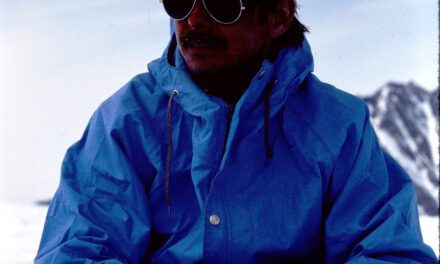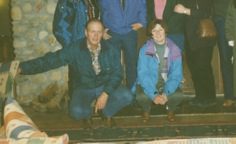(1:39:15) Another incident of great interest, my son (Robbie) was five years old then. He came home at suppertime with this story of about how he had killed this monster with a dagger. He had a rubber dagger. After supper I go out and there is a gang of kids there and they were talking about it. I said, “What is this monster?” It ended up it was a bat. I said, “Anything like that, you just leave it alone.” One kid said, “Well, the monster bit Mikey.” I checked who Mikey was. He was one of the section man’s kids. So I went down and checked with him. When I checked with him, he described the bat. I found out where it was there, it was underneath the propane tank. So you couldn’t tell where the bite was. Kids knees are just a mass of scars, scrapes and that. I went over and I got the bat in my fishing net…So, I got Pete White to take my station-wagon and head to Lethbridge. That was the closest place where we could get it tested. This was after supper, so he drove overnight and he was down there for eight o’clock in the morning. Because it was still alive, they were able to get an immediate test done on it. It was positive. It had rabies. So we got the kid and took him down to Golden and they had a plane there to take him into Vancouver. They got him to Vancouver and he had to have 16 shots in his stomach, but it saved him…It was a hoary bat. There were lots of bats around Yoho actually…but there are no hoary bats. They basically don’t come north of Vancouver. So we figured it came up on a rail car. A week or two later we get word from the campground that a squirrel had bit somebody. So we had to go catch squirrels because we had rabies in the park…It turned out negative. Again we had to close that campground for a few days and it caused a big kerfuffle.
(1:43:03) Then at Kicking Horse Campground, there are old mine sites. You can see them from the road. There was a mine just above that campground. They were getting their water supply from it, they had it piped down… Gordie and I climbed up and the dam was only about this high… it was far enough back into the cave that the insects and bugs didn’t get into the water. Except when I got home, I thought that is all well and good, except for one thing, it is a lead mine. I took another test right above where the warden house used to be, where the filling station is at Yoho, across the road from that was the (Warden house). The tests came back. The one at the Kicking Horse (Campground, there was) no trace of lead. The one from behind the (Warden) house there was quite a bit of lead! All it showed was that they put their mine in the wrong place. There was no mine near that particular area. There was barely lead in that mountain back there. At any rate, that one caused quite a kerfuffle too. The Superintendent didn’t want the tests and I said, “The thing is it is not the tourists that are going through, it won’t have any effect on them, but you have the same staff coming back year after year. By this time he was conceding a few points!…That whole park, it just seemed to be one thing after the other!
(1:45:34) Then of course we had our fire. The Amiskwi fire was a big fire to start with. We had a lookout out there and actually the lookout didn’t detect it. Fred Dixon was out there on patrol, and he thought that he smelled smoke. While we were up there the fire broke out…things were so dry that year that if you took a pine needle and rubbed it together between your fingers it would turn to powder. ..When it (the fire) got going, it just spread. We ended up with nine fires in the Park before that summer was over. We had a good kitchen and bunkhouse set up. But then when it really got going and we had a couple more break out in other areas it became a real huge area. I phoned Region and asked them to send somebody out. George Rogers was in charge and he said, “You’ve got the best trained man, we’ve got!” I was just out of the Hinton School. I had Peter Whyte (there) and we had just gone to the Hinton School. He was my helper. So, we had the technical knowledge there. I had some experience so we were able to (deal with the fire). But it was big…We needed tents, we needed mattresses, we needed hoses. When it was all going, we had a couple of hundred men out there making sure that it didn’t get over the pass onto the ten dollar bill (Moraine Lake)! Anyhow we got word from the province that you better not let that thing get over the pass into our territory. There was lots of help that way!
(1:49:10) We ended up getting water bombers coming in. The smoke was so bad and it was new terrain (for the pilots) and everything, and they were dropping from such a height that it was just totally ineffective…They were just completely useless. We (also) had helicopters. We ended up with what was the largest helicopter water bomb operation in North America, for that given time. It’s just a matter of routine today. But at that time they had never been used that much. We had three American machines in there and we ended up getting Jim Davies in with a big 206 or 204. Between the Americans, particularly this one guy, he was a big grandstander (and) they were sort of outdoing each other with water bombing and this sort of thing. They were all staying at the Wapta Lodge. One time on the radio, I heard the guys on the ground saying “No, no up there on the other side of that tree.” That’s how precise (pilot Jim Davies could fly). We had it set up that there was a machine loading, and a machine hovering. When one took off, the other one was on. They were just circling. We were able to put four-man crews in and we were slinging the guys into the spot fires and they were hitting them before they took off. They would just go in with shovels and a couple of geekey bags. We were getting lightening storms and I have a picture of one of the lightning strikes that started a fire. It is quite a picture. Anyhow that was a big operation. It ended up at one point that a guy came up from Ottawa. We had a cold front coming in and I knew it. I cleared everybody and I told them, “There was one little section of line, and if you can get that changed, and get it back fired before the front hits that will really help. So just work on that one. If I say, ‘Get out, get out!’ Your time is very limited.” Two native guys with a fire pump…set up on a pass so if any sparks flew up from a fire landed up there they could be on it, right quick. Nobody had told them not to go up. They went up there and they had a two way radio, but unfortunately they didn’t know that we had a two channel system, one was direct and the other was relay. They were on the relay one and the work station was over in Banff. At any rate, Gordie Rutherford literally ran up that mountain and got a hold of them and got them out of there. They were just a couple of jumps ahead (of the fire).
(1:54:12) I had (the two guys from Ottawa) up in the helicopter and when that thing blew up, it was just like an atomic bomb. It was just a huge mushroom cloud. One guy when we got down on the ground, phoned George Rogers and he said, “Give Andy everything he wants!” I didn’t have to worry from that point on about saving costs! It ended up being one of the better costs that is one of the fallacies of fires…If it’s really big, your costs go down. The cost per acre was quite good. Mind you, the burning of the Amiskwi Valley was also ecologically a good thing because the whole thing was a mess because of the logging that had taken place there.




Excellent history of what it was like to be a warden from Andy Anderson. Thanks for posting this story.